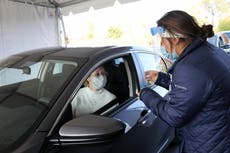Half a million Americans could die of coronavirus by February, study reveals
Around 130,000 lives could be saved if country adopted “universal” mask-wearing
The coronavirus death toll in the US could have reached more than half a million by February, a new study has predicted.
The modelling, carried out be researchers at the University of Washington’s Institute for Health Metrics and Evaluation (IHME), predicted that 511,373 lives could be lost to Covid-19 across the United States by 28 February 2021.
If the research is correct, a much-feared third peak of the virus in the country could lead to the deaths of nearly 300,000 people over the next four months.
The study mapped out various scenarios and their projected impact on the spread of the Covid-19 across the US.
Researchers predict that “under all scenarios evaluated” in the report, the US is “likely to face a continued public health challenge from the Covid-19” into next year.
“We are heading into a very substantial fall/winter surge,” IHME Director Chris Murray, who co-led the research, said.
The study’s release comes just after president Donald Trump insisted that the US is “turning the corner” on the coronavirus pandemic and that it is “going away” during the final presidential debate on Thursday.
Mr Murray said the projections, alongside rising infection rates, demonstrates that there is no basis to “the idea that the pandemic is going away,” adding: “We do not believe that is true”.
In the report, non-pharmaceutical interventions (NPIs) such as face masks, social distancing mandates, restrictions of gatherings and stay-at-home orders are credited with reducing transmission of the virus while there remains no vaccine or effective treatment.
For example, researchers estimate around 130,000 lives could be saved if a universal mask police was implemented in the country.
“Expanding mask use is one of the easy wins for the United States ... and can save many lives,” Mr Murray said.
The news comes just after the number of people hospitalised with coronavirus in the US soared to a two-month high as the number of patients surpassed 40,000 for the first time since August.
According to an analysis by Reuters, hospitals have seen a 36 per cent rise in coronavirus patients over the past four weeks with hospitalisations reaching 40,264 on Wednesday.
Midwest states including Iowa, Kansas, Missouri, Nebraska, North Dakota, South Dakota, and Wisconsin, have all reported record numbers of hospitalisations.
Health experts have long feared that America is staring down the barrel of a third wave of coronavirus infections due to coincide with flu season.
“Our worry has been that we would see a fall wave, that we’d see a big resurgence in the fall,” Justin Lessler, an associate professor of epidemiology at the Johns Hopkins Bloomberg School of Public Health told CNBC.
“And that has really been something I think all of us in the public health community have been worried about for a while.”
The US has recorded more than 8.5 million cases of the novel coronavirus and over 223,000 deaths since the outbreak took hold of the country in March.
“We expect the surge to steadily grow across different states and at the national level, and to continue to increase as we head towards high levels of daily deaths in late December and in January,” Mr Murray said.
The publication of the study on Friday in Nature was the first time the IHME has projected deaths beyond 1 February. Its current forecast on its website is for 386,000 deaths as of 1 February.
Globally, the number of new infections around the world continues to grow at an accelerating rate, averaging more than 350,000 per day and passing 40 million in total just one month after passing 30 million.
Additional reporting by Reuters
Join our commenting forum
Join thought-provoking conversations, follow other Independent readers and see their replies
Comments




Bookmark popover
Removed from bookmarks